Comparative Analysis of Musical Theatre Pieces
VerifiedAdded on 2021/04/21
|7
|2060
|140
AI Summary
The assignment compares and contrasts the musical theatre pieces 'My Fair Lady' and 'Les Miserables'. It discusses the similarities between the two, such as their use of musical numbers to convey emotions and themes. However, it also highlights their differences, including the tone and texture of the music in each piece. The analysis concludes that while both works are unique and effective in their own right, they have distinct qualities that set them apart from one another.
Contribute Materials
Your contribution can guide someone’s learning journey. Share your
documents today.
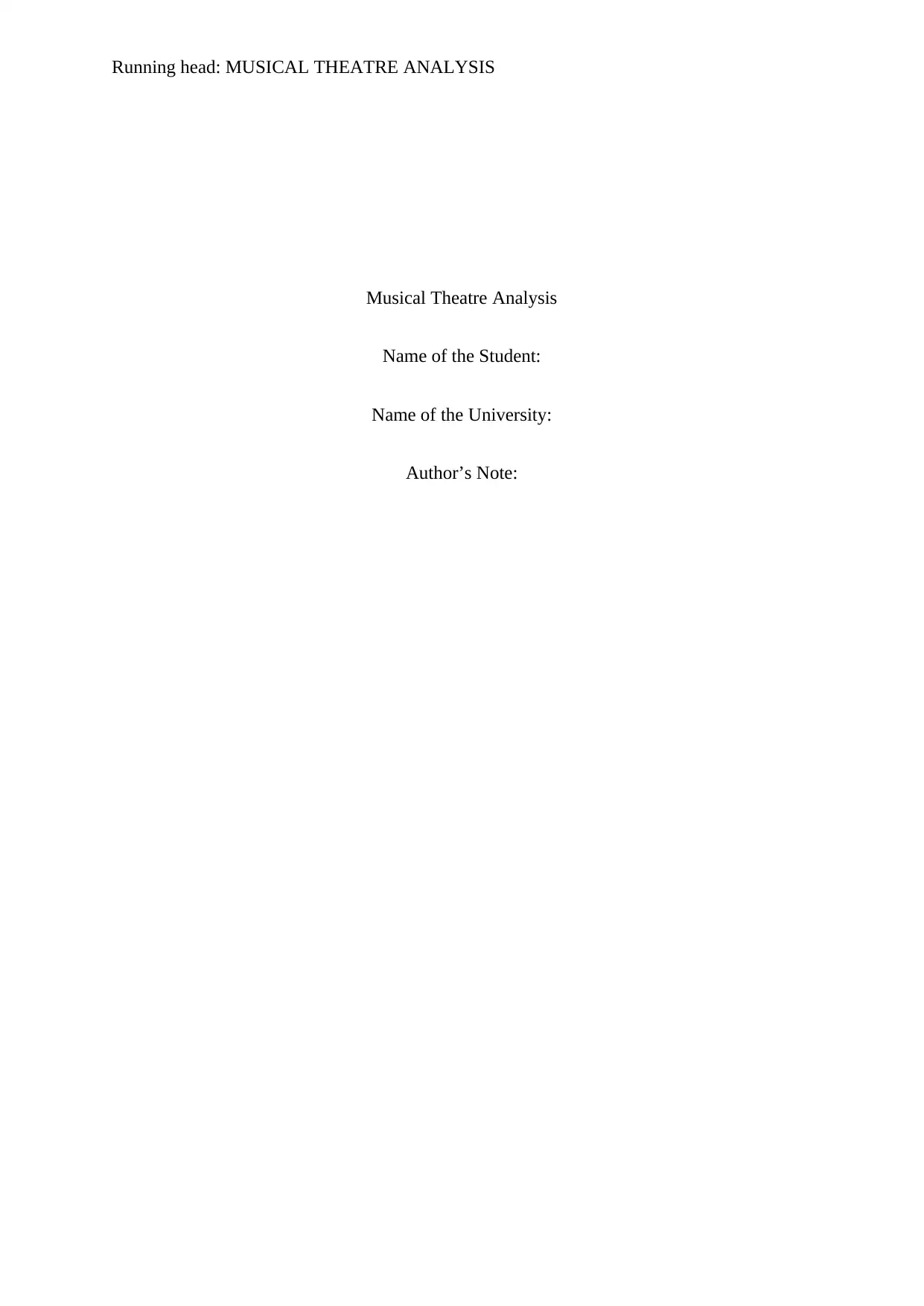
Running head: MUSICAL THEATRE ANALYSIS
Musical Theatre Analysis
Name of the Student:
Name of the University:
Author’s Note:
Musical Theatre Analysis
Name of the Student:
Name of the University:
Author’s Note:
Secure Best Marks with AI Grader
Need help grading? Try our AI Grader for instant feedback on your assignments.
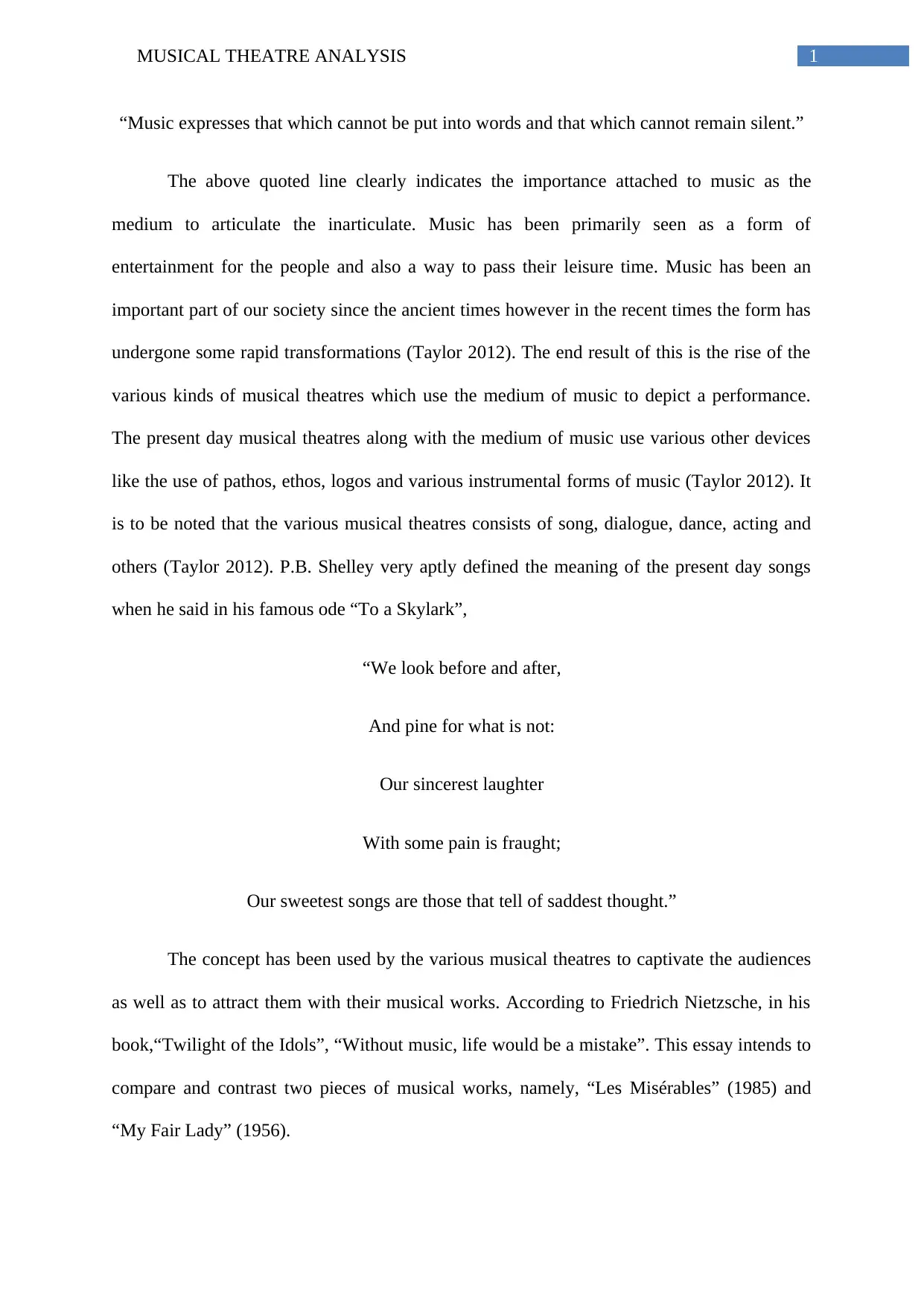
1MUSICAL THEATRE ANALYSIS
“Music expresses that which cannot be put into words and that which cannot remain silent.”
The above quoted line clearly indicates the importance attached to music as the
medium to articulate the inarticulate. Music has been primarily seen as a form of
entertainment for the people and also a way to pass their leisure time. Music has been an
important part of our society since the ancient times however in the recent times the form has
undergone some rapid transformations (Taylor 2012). The end result of this is the rise of the
various kinds of musical theatres which use the medium of music to depict a performance.
The present day musical theatres along with the medium of music use various other devices
like the use of pathos, ethos, logos and various instrumental forms of music (Taylor 2012). It
is to be noted that the various musical theatres consists of song, dialogue, dance, acting and
others (Taylor 2012). P.B. Shelley very aptly defined the meaning of the present day songs
when he said in his famous ode “To a Skylark”,
“We look before and after,
And pine for what is not:
Our sincerest laughter
With some pain is fraught;
Our sweetest songs are those that tell of saddest thought.”
The concept has been used by the various musical theatres to captivate the audiences
as well as to attract them with their musical works. According to Friedrich Nietzsche, in his
book,“Twilight of the Idols”, “Without music, life would be a mistake”. This essay intends to
compare and contrast two pieces of musical works, namely, “Les Misérables” (1985) and
“My Fair Lady” (1956).
“Music expresses that which cannot be put into words and that which cannot remain silent.”
The above quoted line clearly indicates the importance attached to music as the
medium to articulate the inarticulate. Music has been primarily seen as a form of
entertainment for the people and also a way to pass their leisure time. Music has been an
important part of our society since the ancient times however in the recent times the form has
undergone some rapid transformations (Taylor 2012). The end result of this is the rise of the
various kinds of musical theatres which use the medium of music to depict a performance.
The present day musical theatres along with the medium of music use various other devices
like the use of pathos, ethos, logos and various instrumental forms of music (Taylor 2012). It
is to be noted that the various musical theatres consists of song, dialogue, dance, acting and
others (Taylor 2012). P.B. Shelley very aptly defined the meaning of the present day songs
when he said in his famous ode “To a Skylark”,
“We look before and after,
And pine for what is not:
Our sincerest laughter
With some pain is fraught;
Our sweetest songs are those that tell of saddest thought.”
The concept has been used by the various musical theatres to captivate the audiences
as well as to attract them with their musical works. According to Friedrich Nietzsche, in his
book,“Twilight of the Idols”, “Without music, life would be a mistake”. This essay intends to
compare and contrast two pieces of musical works, namely, “Les Misérables” (1985) and
“My Fair Lady” (1956).
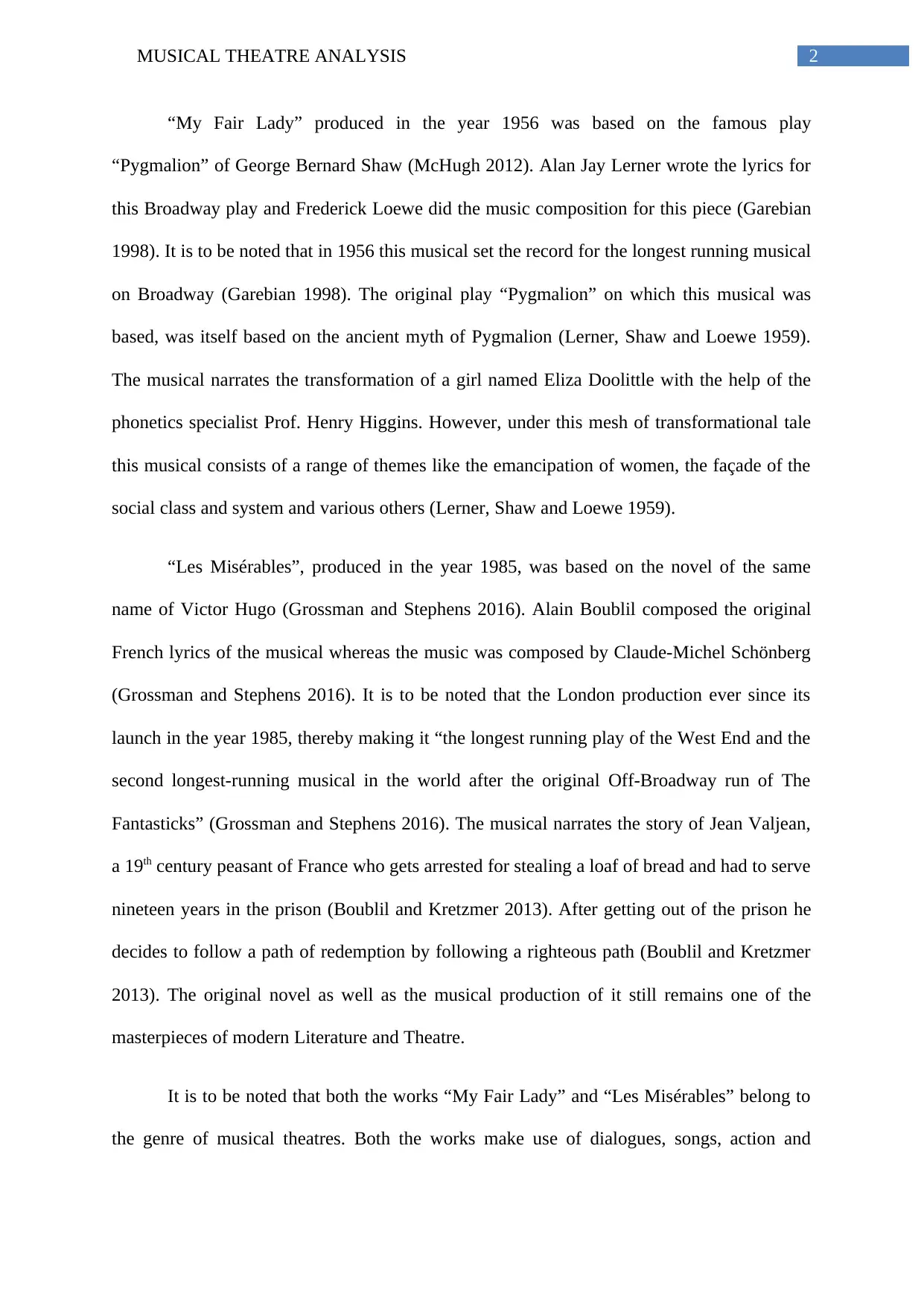
2MUSICAL THEATRE ANALYSIS
“My Fair Lady” produced in the year 1956 was based on the famous play
“Pygmalion” of George Bernard Shaw (McHugh 2012). Alan Jay Lerner wrote the lyrics for
this Broadway play and Frederick Loewe did the music composition for this piece (Garebian
1998). It is to be noted that in 1956 this musical set the record for the longest running musical
on Broadway (Garebian 1998). The original play “Pygmalion” on which this musical was
based, was itself based on the ancient myth of Pygmalion (Lerner, Shaw and Loewe 1959).
The musical narrates the transformation of a girl named Eliza Doolittle with the help of the
phonetics specialist Prof. Henry Higgins. However, under this mesh of transformational tale
this musical consists of a range of themes like the emancipation of women, the façade of the
social class and system and various others (Lerner, Shaw and Loewe 1959).
“Les Misérables”, produced in the year 1985, was based on the novel of the same
name of Victor Hugo (Grossman and Stephens 2016). Alain Boublil composed the original
French lyrics of the musical whereas the music was composed by Claude-Michel Schönberg
(Grossman and Stephens 2016). It is to be noted that the London production ever since its
launch in the year 1985, thereby making it “the longest running play of the West End and the
second longest-running musical in the world after the original Off-Broadway run of The
Fantasticks” (Grossman and Stephens 2016). The musical narrates the story of Jean Valjean,
a 19th century peasant of France who gets arrested for stealing a loaf of bread and had to serve
nineteen years in the prison (Boublil and Kretzmer 2013). After getting out of the prison he
decides to follow a path of redemption by following a righteous path (Boublil and Kretzmer
2013). The original novel as well as the musical production of it still remains one of the
masterpieces of modern Literature and Theatre.
It is to be noted that both the works “My Fair Lady” and “Les Misérables” belong to
the genre of musical theatres. Both the works make use of dialogues, songs, action and
“My Fair Lady” produced in the year 1956 was based on the famous play
“Pygmalion” of George Bernard Shaw (McHugh 2012). Alan Jay Lerner wrote the lyrics for
this Broadway play and Frederick Loewe did the music composition for this piece (Garebian
1998). It is to be noted that in 1956 this musical set the record for the longest running musical
on Broadway (Garebian 1998). The original play “Pygmalion” on which this musical was
based, was itself based on the ancient myth of Pygmalion (Lerner, Shaw and Loewe 1959).
The musical narrates the transformation of a girl named Eliza Doolittle with the help of the
phonetics specialist Prof. Henry Higgins. However, under this mesh of transformational tale
this musical consists of a range of themes like the emancipation of women, the façade of the
social class and system and various others (Lerner, Shaw and Loewe 1959).
“Les Misérables”, produced in the year 1985, was based on the novel of the same
name of Victor Hugo (Grossman and Stephens 2016). Alain Boublil composed the original
French lyrics of the musical whereas the music was composed by Claude-Michel Schönberg
(Grossman and Stephens 2016). It is to be noted that the London production ever since its
launch in the year 1985, thereby making it “the longest running play of the West End and the
second longest-running musical in the world after the original Off-Broadway run of The
Fantasticks” (Grossman and Stephens 2016). The musical narrates the story of Jean Valjean,
a 19th century peasant of France who gets arrested for stealing a loaf of bread and had to serve
nineteen years in the prison (Boublil and Kretzmer 2013). After getting out of the prison he
decides to follow a path of redemption by following a righteous path (Boublil and Kretzmer
2013). The original novel as well as the musical production of it still remains one of the
masterpieces of modern Literature and Theatre.
It is to be noted that both the works “My Fair Lady” and “Les Misérables” belong to
the genre of musical theatres. Both the works make use of dialogues, songs, action and
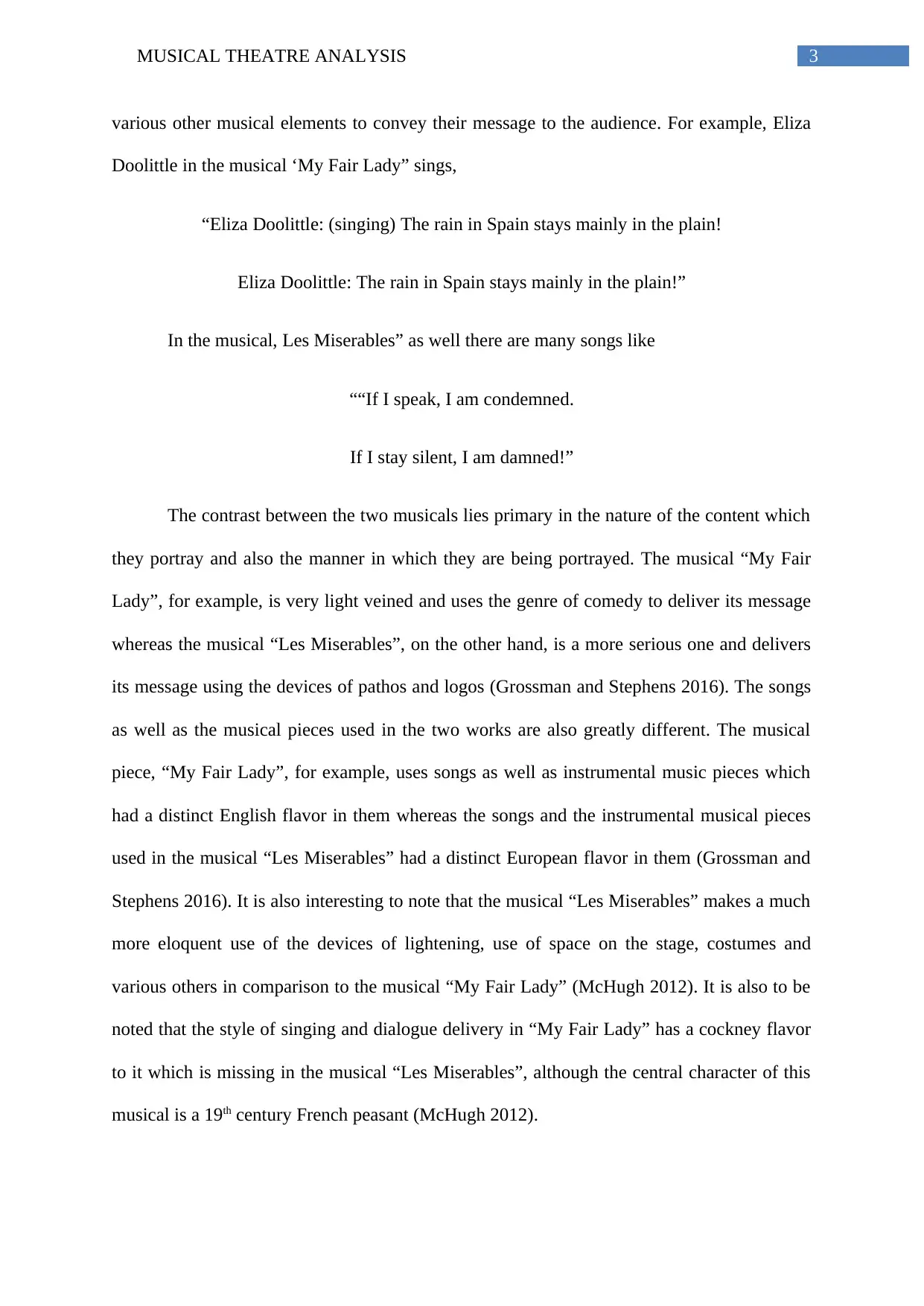
3MUSICAL THEATRE ANALYSIS
various other musical elements to convey their message to the audience. For example, Eliza
Doolittle in the musical ‘My Fair Lady” sings,
“Eliza Doolittle: (singing) The rain in Spain stays mainly in the plain!
Eliza Doolittle: The rain in Spain stays mainly in the plain!”
In the musical, Les Miserables” as well there are many songs like
““If I speak, I am condemned.
If I stay silent, I am damned!”
The contrast between the two musicals lies primary in the nature of the content which
they portray and also the manner in which they are being portrayed. The musical “My Fair
Lady”, for example, is very light veined and uses the genre of comedy to deliver its message
whereas the musical “Les Miserables”, on the other hand, is a more serious one and delivers
its message using the devices of pathos and logos (Grossman and Stephens 2016). The songs
as well as the musical pieces used in the two works are also greatly different. The musical
piece, “My Fair Lady”, for example, uses songs as well as instrumental music pieces which
had a distinct English flavor in them whereas the songs and the instrumental musical pieces
used in the musical “Les Miserables” had a distinct European flavor in them (Grossman and
Stephens 2016). It is also interesting to note that the musical “Les Miserables” makes a much
more eloquent use of the devices of lightening, use of space on the stage, costumes and
various others in comparison to the musical “My Fair Lady” (McHugh 2012). It is also to be
noted that the style of singing and dialogue delivery in “My Fair Lady” has a cockney flavor
to it which is missing in the musical “Les Miserables”, although the central character of this
musical is a 19th century French peasant (McHugh 2012).
various other musical elements to convey their message to the audience. For example, Eliza
Doolittle in the musical ‘My Fair Lady” sings,
“Eliza Doolittle: (singing) The rain in Spain stays mainly in the plain!
Eliza Doolittle: The rain in Spain stays mainly in the plain!”
In the musical, Les Miserables” as well there are many songs like
““If I speak, I am condemned.
If I stay silent, I am damned!”
The contrast between the two musicals lies primary in the nature of the content which
they portray and also the manner in which they are being portrayed. The musical “My Fair
Lady”, for example, is very light veined and uses the genre of comedy to deliver its message
whereas the musical “Les Miserables”, on the other hand, is a more serious one and delivers
its message using the devices of pathos and logos (Grossman and Stephens 2016). The songs
as well as the musical pieces used in the two works are also greatly different. The musical
piece, “My Fair Lady”, for example, uses songs as well as instrumental music pieces which
had a distinct English flavor in them whereas the songs and the instrumental musical pieces
used in the musical “Les Miserables” had a distinct European flavor in them (Grossman and
Stephens 2016). It is also interesting to note that the musical “Les Miserables” makes a much
more eloquent use of the devices of lightening, use of space on the stage, costumes and
various others in comparison to the musical “My Fair Lady” (McHugh 2012). It is also to be
noted that the style of singing and dialogue delivery in “My Fair Lady” has a cockney flavor
to it which is missing in the musical “Les Miserables”, although the central character of this
musical is a 19th century French peasant (McHugh 2012).
Secure Best Marks with AI Grader
Need help grading? Try our AI Grader for instant feedback on your assignments.
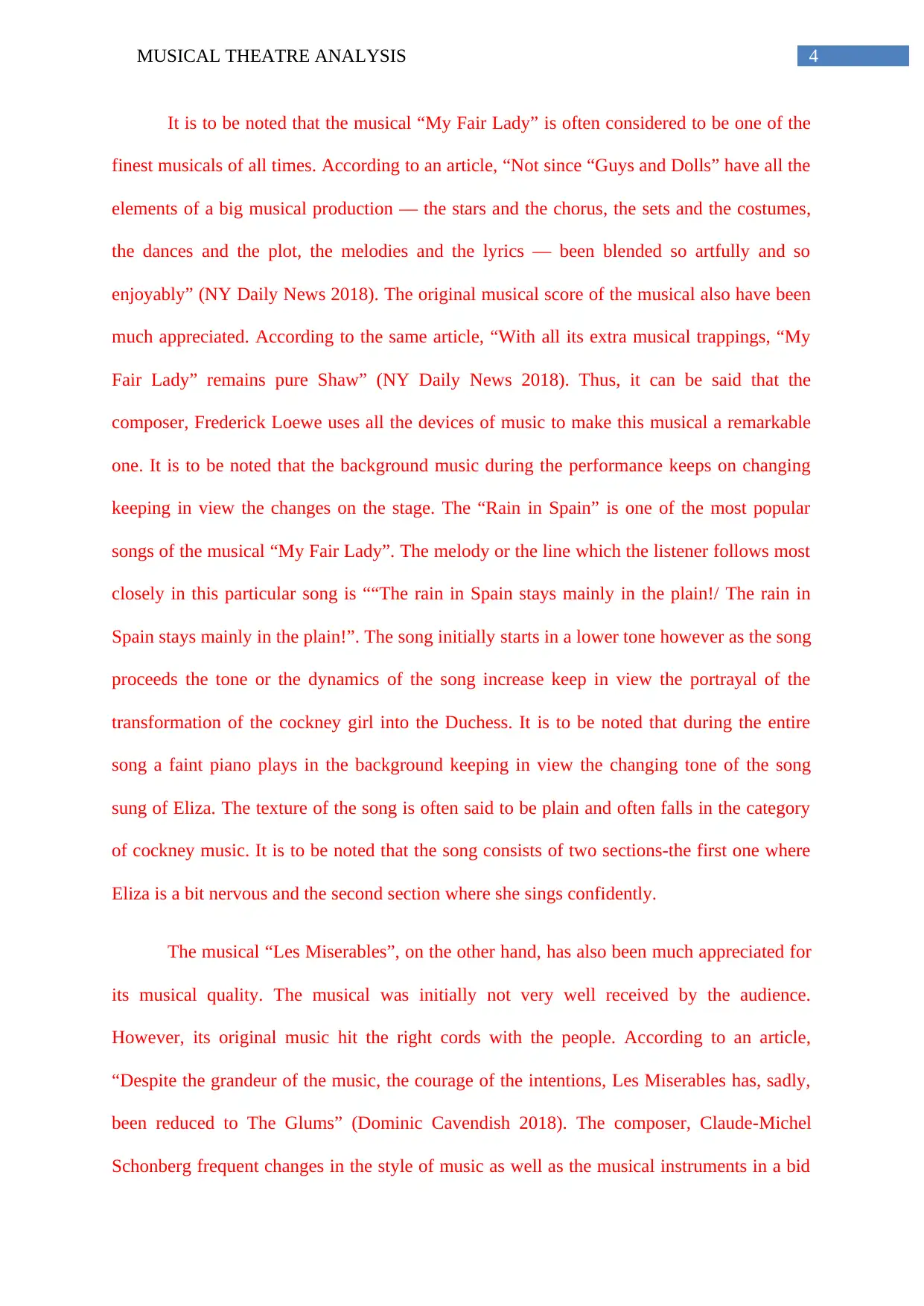
4MUSICAL THEATRE ANALYSIS
It is to be noted that the musical “My Fair Lady” is often considered to be one of the
finest musicals of all times. According to an article, “Not since “Guys and Dolls” have all the
elements of a big musical production — the stars and the chorus, the sets and the costumes,
the dances and the plot, the melodies and the lyrics — been blended so artfully and so
enjoyably” (NY Daily News 2018). The original musical score of the musical also have been
much appreciated. According to the same article, “With all its extra musical trappings, “My
Fair Lady” remains pure Shaw” (NY Daily News 2018). Thus, it can be said that the
composer, Frederick Loewe uses all the devices of music to make this musical a remarkable
one. It is to be noted that the background music during the performance keeps on changing
keeping in view the changes on the stage. The “Rain in Spain” is one of the most popular
songs of the musical “My Fair Lady”. The melody or the line which the listener follows most
closely in this particular song is ““The rain in Spain stays mainly in the plain!/ The rain in
Spain stays mainly in the plain!”. The song initially starts in a lower tone however as the song
proceeds the tone or the dynamics of the song increase keep in view the portrayal of the
transformation of the cockney girl into the Duchess. It is to be noted that during the entire
song a faint piano plays in the background keeping in view the changing tone of the song
sung of Eliza. The texture of the song is often said to be plain and often falls in the category
of cockney music. It is to be noted that the song consists of two sections-the first one where
Eliza is a bit nervous and the second section where she sings confidently.
The musical “Les Miserables”, on the other hand, has also been much appreciated for
its musical quality. The musical was initially not very well received by the audience.
However, its original music hit the right cords with the people. According to an article,
“Despite the grandeur of the music, the courage of the intentions, Les Miserables has, sadly,
been reduced to The Glums” (Dominic Cavendish 2018). The composer, Claude-Michel
Schonberg frequent changes in the style of music as well as the musical instruments in a bid
It is to be noted that the musical “My Fair Lady” is often considered to be one of the
finest musicals of all times. According to an article, “Not since “Guys and Dolls” have all the
elements of a big musical production — the stars and the chorus, the sets and the costumes,
the dances and the plot, the melodies and the lyrics — been blended so artfully and so
enjoyably” (NY Daily News 2018). The original musical score of the musical also have been
much appreciated. According to the same article, “With all its extra musical trappings, “My
Fair Lady” remains pure Shaw” (NY Daily News 2018). Thus, it can be said that the
composer, Frederick Loewe uses all the devices of music to make this musical a remarkable
one. It is to be noted that the background music during the performance keeps on changing
keeping in view the changes on the stage. The “Rain in Spain” is one of the most popular
songs of the musical “My Fair Lady”. The melody or the line which the listener follows most
closely in this particular song is ““The rain in Spain stays mainly in the plain!/ The rain in
Spain stays mainly in the plain!”. The song initially starts in a lower tone however as the song
proceeds the tone or the dynamics of the song increase keep in view the portrayal of the
transformation of the cockney girl into the Duchess. It is to be noted that during the entire
song a faint piano plays in the background keeping in view the changing tone of the song
sung of Eliza. The texture of the song is often said to be plain and often falls in the category
of cockney music. It is to be noted that the song consists of two sections-the first one where
Eliza is a bit nervous and the second section where she sings confidently.
The musical “Les Miserables”, on the other hand, has also been much appreciated for
its musical quality. The musical was initially not very well received by the audience.
However, its original music hit the right cords with the people. According to an article,
“Despite the grandeur of the music, the courage of the intentions, Les Miserables has, sadly,
been reduced to The Glums” (Dominic Cavendish 2018). The composer, Claude-Michel
Schonberg frequent changes in the style of music as well as the musical instruments in a bid
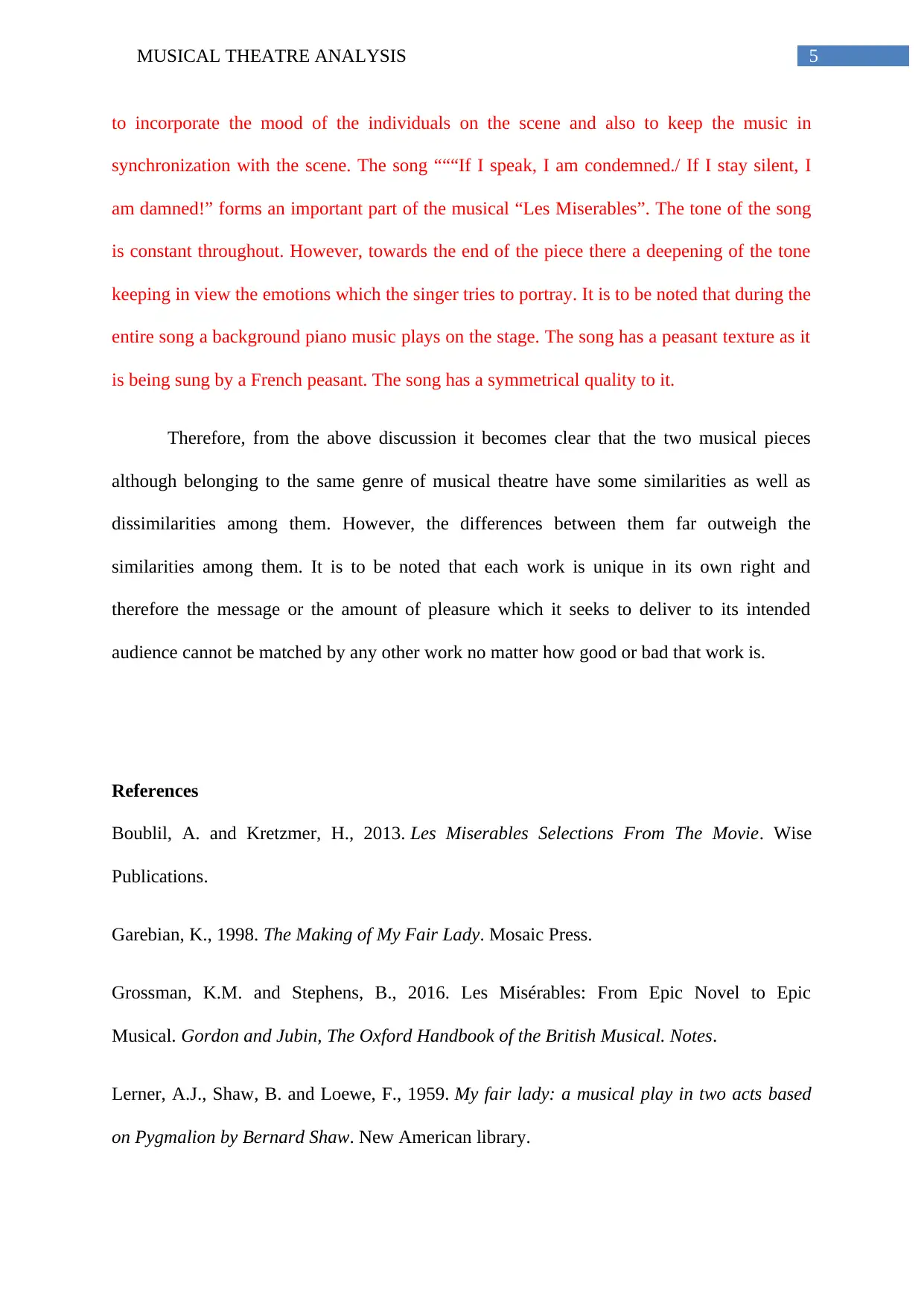
5MUSICAL THEATRE ANALYSIS
to incorporate the mood of the individuals on the scene and also to keep the music in
synchronization with the scene. The song “““If I speak, I am condemned./ If I stay silent, I
am damned!” forms an important part of the musical “Les Miserables”. The tone of the song
is constant throughout. However, towards the end of the piece there a deepening of the tone
keeping in view the emotions which the singer tries to portray. It is to be noted that during the
entire song a background piano music plays on the stage. The song has a peasant texture as it
is being sung by a French peasant. The song has a symmetrical quality to it.
Therefore, from the above discussion it becomes clear that the two musical pieces
although belonging to the same genre of musical theatre have some similarities as well as
dissimilarities among them. However, the differences between them far outweigh the
similarities among them. It is to be noted that each work is unique in its own right and
therefore the message or the amount of pleasure which it seeks to deliver to its intended
audience cannot be matched by any other work no matter how good or bad that work is.
References
Boublil, A. and Kretzmer, H., 2013. Les Miserables Selections From The Movie. Wise
Publications.
Garebian, K., 1998. The Making of My Fair Lady. Mosaic Press.
Grossman, K.M. and Stephens, B., 2016. Les Misérables: From Epic Novel to Epic
Musical. Gordon and Jubin, The Oxford Handbook of the British Musical. Notes.
Lerner, A.J., Shaw, B. and Loewe, F., 1959. My fair lady: a musical play in two acts based
on Pygmalion by Bernard Shaw. New American library.
to incorporate the mood of the individuals on the scene and also to keep the music in
synchronization with the scene. The song “““If I speak, I am condemned./ If I stay silent, I
am damned!” forms an important part of the musical “Les Miserables”. The tone of the song
is constant throughout. However, towards the end of the piece there a deepening of the tone
keeping in view the emotions which the singer tries to portray. It is to be noted that during the
entire song a background piano music plays on the stage. The song has a peasant texture as it
is being sung by a French peasant. The song has a symmetrical quality to it.
Therefore, from the above discussion it becomes clear that the two musical pieces
although belonging to the same genre of musical theatre have some similarities as well as
dissimilarities among them. However, the differences between them far outweigh the
similarities among them. It is to be noted that each work is unique in its own right and
therefore the message or the amount of pleasure which it seeks to deliver to its intended
audience cannot be matched by any other work no matter how good or bad that work is.
References
Boublil, A. and Kretzmer, H., 2013. Les Miserables Selections From The Movie. Wise
Publications.
Garebian, K., 1998. The Making of My Fair Lady. Mosaic Press.
Grossman, K.M. and Stephens, B., 2016. Les Misérables: From Epic Novel to Epic
Musical. Gordon and Jubin, The Oxford Handbook of the British Musical. Notes.
Lerner, A.J., Shaw, B. and Loewe, F., 1959. My fair lady: a musical play in two acts based
on Pygmalion by Bernard Shaw. New American library.
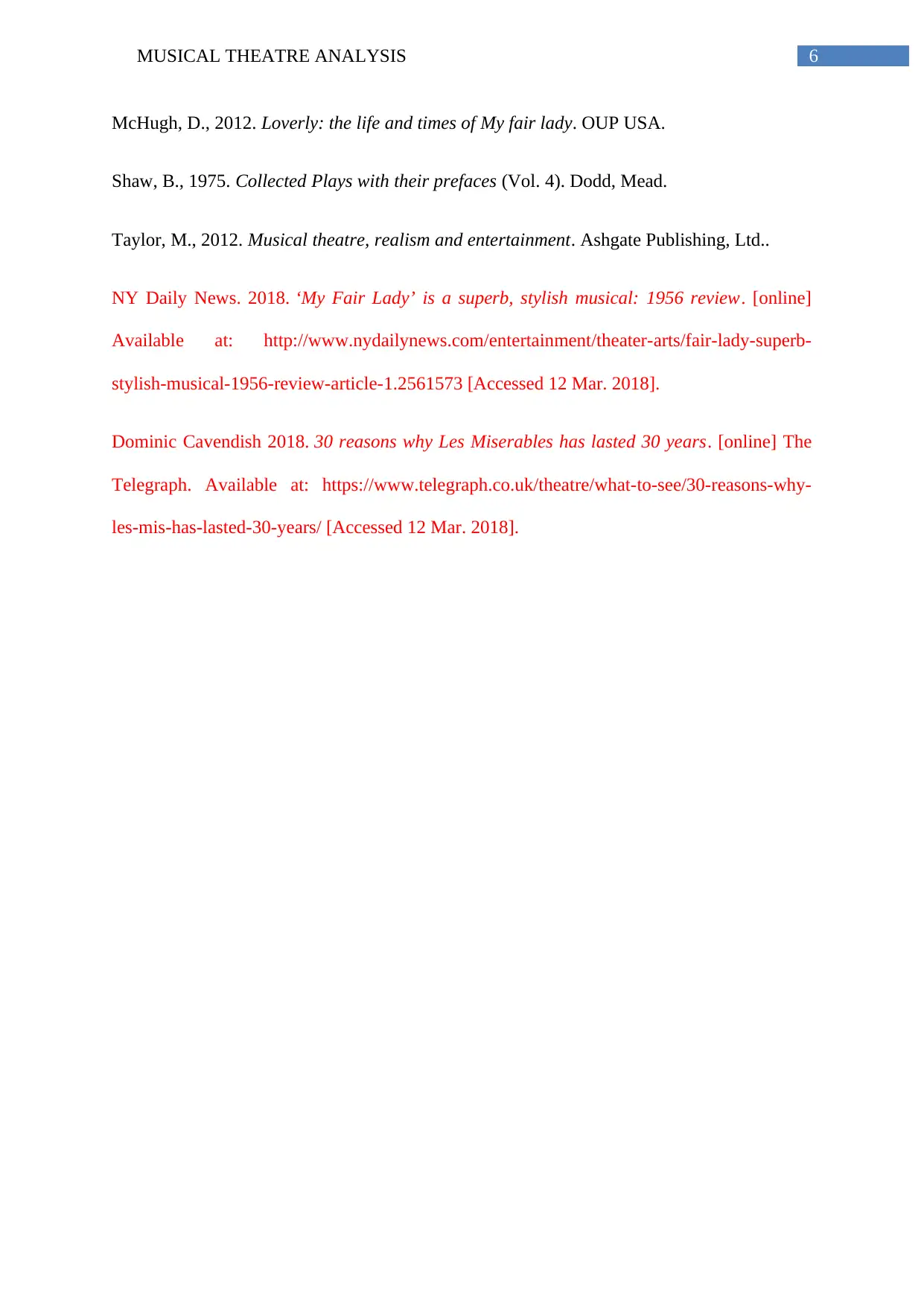
6MUSICAL THEATRE ANALYSIS
McHugh, D., 2012. Loverly: the life and times of My fair lady. OUP USA.
Shaw, B., 1975. Collected Plays with their prefaces (Vol. 4). Dodd, Mead.
Taylor, M., 2012. Musical theatre, realism and entertainment. Ashgate Publishing, Ltd..
NY Daily News. 2018. ‘My Fair Lady’ is a superb, stylish musical: 1956 review. [online]
Available at: http://www.nydailynews.com/entertainment/theater-arts/fair-lady-superb-
stylish-musical-1956-review-article-1.2561573 [Accessed 12 Mar. 2018].
Dominic Cavendish 2018. 30 reasons why Les Miserables has lasted 30 years. [online] The
Telegraph. Available at: https://www.telegraph.co.uk/theatre/what-to-see/30-reasons-why-
les-mis-has-lasted-30-years/ [Accessed 12 Mar. 2018].
McHugh, D., 2012. Loverly: the life and times of My fair lady. OUP USA.
Shaw, B., 1975. Collected Plays with their prefaces (Vol. 4). Dodd, Mead.
Taylor, M., 2012. Musical theatre, realism and entertainment. Ashgate Publishing, Ltd..
NY Daily News. 2018. ‘My Fair Lady’ is a superb, stylish musical: 1956 review. [online]
Available at: http://www.nydailynews.com/entertainment/theater-arts/fair-lady-superb-
stylish-musical-1956-review-article-1.2561573 [Accessed 12 Mar. 2018].
Dominic Cavendish 2018. 30 reasons why Les Miserables has lasted 30 years. [online] The
Telegraph. Available at: https://www.telegraph.co.uk/theatre/what-to-see/30-reasons-why-
les-mis-has-lasted-30-years/ [Accessed 12 Mar. 2018].
1 out of 7
Your All-in-One AI-Powered Toolkit for Academic Success.
+13062052269
info@desklib.com
Available 24*7 on WhatsApp / Email
![[object Object]](/_next/static/media/star-bottom.7253800d.svg)
Unlock your academic potential
© 2024 | Zucol Services PVT LTD | All rights reserved.